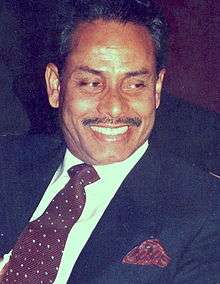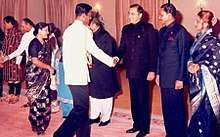1985 in Bangladesh
1985 (MCMLXXXV) was a common year starting on Tuesday of the Gregorian calendar, the 1985th year of the Common Era (CE) and Anno Domini (AD) designations, the 985th year of the 2nd millennium, the 85th year of the 20th century, and the 6th year of the 1980s decade.
| |||||
| Centuries: |
| ||||
|---|---|---|---|---|---|
| Decades: |
| ||||
| See also: | Other events of 1985 List of years in Bangladesh | ||||
The year 1985 was the 14th year after the independence of Bangladesh. It was also the fourth year of the Government of Hussain Muhammad Ershad.
Incumbents

H. M.
Ershad
Ershad
- President: Hussain Muhammad Ershad
- Prime Minister: Ataur Rahman Khan
- Chief Justice: F.K.M. Munim
Demography
| Population, total | 93,199,865 |
| Population density (per km2) | 716.0 |
| Population growth (annual %) | 2.7% |
| Male to Female Ratio (every 100 Female) | 104.6 |
| Urban population (% of total) | 17.5% |
| Birth rate, crude (per 1,000 people) | 40.2 |
| Death rate, crude (per 1,000 people) | 12.4 |
| Mortality rate, under 5 (per 1,000 live births) | 173.5 |
| Life expectancy at birth, total (years) | 55.6 |
| Fertility rate, total (births per woman) | 5.5 |
Climate
| Climate data for Bangladesh in 1985 | |||||||||||||
|---|---|---|---|---|---|---|---|---|---|---|---|---|---|
| Month | Jan | Feb | Mar | Apr | May | Jun | Jul | Aug | Sep | Oct | Nov | Dec | Year |
| Daily mean °C (°F) | 18.9 (66.0) |
20.6 (69.1) |
26.3 (79.3) |
28.3 (82.9) |
27.6 (81.7) |
28.2 (82.8) |
27.3 (81.1) |
28.4 (83.1) |
27.8 (82.0) |
27. (81) |
23.1 (73.6) |
20.4 (68.7) |
25.4 (77.7) |
| Average precipitation mm (inches) | 7.6 (0.30) |
12.3 (0.48) |
91.5 (3.60) |
113.8 (4.48) |
310.4 (12.22) |
504.2 (19.85) |
429. (16.9) |
327.9 (12.91) |
311.3 (12.26) |
102.1 (4.02) |
34.4 (1.35) |
5.8 (0.23) |
2,250.3 (88.59) |
| Source: Climatic Research Unit (CRU) of University of East Anglia (UEA)[2] | |||||||||||||
Economy
| National Income | |||
|---|---|---|---|
| Current US$ | Current BDT | % of GDP | |
| GDP | $22.3 billion | BDT579.2 billion | |
| GDP growth (annual %) | 3.3% | ||
| GDP per capita | $239.0 | BDT6,215 | |
| Agriculture, value added | $7.6 billion | BDT197.2 billion | 34.8% |
| Industry, value added | $4.5 billion | BDT117.7 billion | 20.8% |
| Services, etc., value added | $9.7 billion | BDT251.3 billion | 44.4% |
| Balance of Payment | |||
| Current US$ | Current BDT | % of GDP | |
| Current account balance | -$455.2 million | -2.0% | |
| Imports of goods and services | $2,764.4 million | BDT74.4 billion | 12.8% |
| Exports of goods and services | $1,237.3 million | BDT31.2 billion | 5.4% |
| Foreign direct investment, net inflows | -$6.7 million | 0.0% | |
| Personal remittances, received | $502.5 million | 2.3% | |
| Total reserves (includes gold) at year end | $356.2 million | ||
| Total reserves in months of imports | 1.5 | ||
Note: For the year 1985 average official exchange rate for BDT was 27.99 per US$.
Events

President H. M. Ershad's Reception of SAARC Heads of States in Dhaka.
- 13 February – Raufun Basunia, Joint Secretary of Bangladesh Chhatra League, and the General Secretary of its University of Dhaka branch was shot dead during a clash between Chhatra Sangram Parishad and Chhatra Samaj, the ruling Jatiyo Party backed student wing in front of Mohsin Hall at University of Dhaka.[3][4]
- 21 March – A referendum on military rule was held in order to confirm the military rule of Hussain Mohammed Ershad. The referendum asked voters "Do you support the policies of President Ershad, and do you want him to continue to run this administration until a civilian government is formed through elections?" The result saw 94.5% vote in favour, with a turnout of 72.2%.[5] The opposition organised a general strike on the day of the referendum, and alleged that the results were fraudulent.
- Heavy mortars were used in an exchange of fire between Bangladeshi and Indian forces on a disputed section of the border between the two nations.[6]
- 22 November – The MOU between Bangladesh and India regarding Ganges water sharing was extended for three years.[7]
- 8 December – The first SAARC summit was held in Dhaka, Bangladesh on 6–8 December 1985 and was attended by the Government representative and president of Bangladesh, Maldives, Pakistan and Sri Lanka, the kings of Bhutan and Nepal, and the prime minister of India.[8] They signed the SAARC Charter on 8 December 1985, thereby establishing the regional association, and established study groups on the problems of terrorism and drug trafficking, as well as planning a ministerial-level meeting about GATT, and a ministerial-level conference on increasing the participation of women at the regional level.[8] The summit also agreed to establish a SAARC secretariat and adopted an official SAARC emblem.[8]
Sports
- South Asian (Federation) Games:
- Domestic football:
- Abahani KC won Dhaka League title while Brothers Union came out runner-up.[10]
- Abahani KC also won Bangladesh Federation Cup title.[11]
Awards and recognitions
- Zafrullah Chowdhury, the founder of Gonoshasthaya Kendra, was awarded Ramon Magsaysay Award.[12]
Births
- 8 April – Masuma Rahman Nabila, actor
- 1 November – Enamul Haque, footballer
Deaths
- 15 March – Aroj Ali Matubbar, author (b. 1900)
- 10 July – Ahsan Habib, poet (b. 1917)
- 17 July – Abdul Hady Talukdar, academician (b. 1905)
- 5 October – Abdus Sattar, former President (b. 1906)
- 30 October – Fazle Lohani, journalist and TV host (b. 1929)
- 4 December – Bijoy Sarkar, baul singer (b. 1903)
References
- "World Development Indicators". The World Bank. Retrieved 27 May 2018.
- "Climate Change Knowledge Portal". The World Bank Group. Retrieved 27 May 2018.
- "Death anniversary of Basunia observed". bdnews24.com. 12 February 2006. Retrieved 2 August 2015.
- "75 DU deaths since '71, none prosecuted". bdnews24.com. 3 February 2010. Retrieved 2 August 2015.
- Dieter Nohlen; Florian Grotz; Christof Hartmann (2001). Elections in Asia: A data handbook. Volume I. p. 534. ISBN 0-19-924958-X.
- "World: South Asia Third day of India Bangladesh clashes". BBC News. 23 August 1999.
- Haq, Enamul (2012). "Ganges Water Sharing". In Islam, Sirajul; Jamal, Ahmed A. (eds.). Banglapedia: National Encyclopedia of Bangladesh (Second ed.). Asiatic Society of Bangladesh.
- "Dhaka Declaration" (PDF). SAARC Secretariat. Retrieved 16 October 2010.
- "South Asian (Federation) Games". Athletics Weekly. Retrieved 31 July 2010.
- "List of Champions". Atsushi Fujioka for Rec.Sport.Soccer Statistics Foundation. Retrieved 16 October 2018.
- "Bangladesh – List of Cup Winners". Ian King, Hans Schöggl and Erlan Manaschev for Rec.Sport.Soccer Statistics Foundation. Retrieved 30 October 2018.
- "Awardees who worked in Bangladesh". Ramon Magsaysay Award Foundation. Archived from the original on 1 July 2018. Retrieved 4 November 2018.
This article is issued from Wikipedia. The text is licensed under Creative Commons - Attribution - Sharealike. Additional terms may apply for the media files.